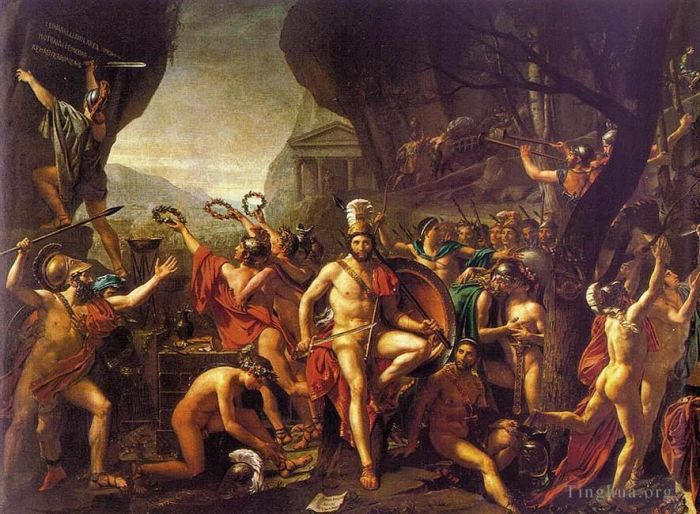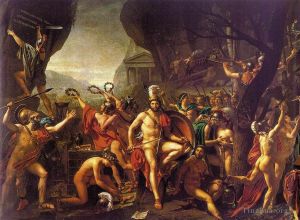Leonidas at Thermopylae
Jacques-Louis David
- Price: Price on Request
- Art Type: Oil Painting
- Size:
- English Comments: 0
- International Comments: 0
- Creating Date:
- Introduction and Works of Jacques-Louis David >>
Keywords:
Leonidas, Thermopylae
Work Overview
- Leonidas at Thermopylae
Artist Jacques-Louis David
Year 1814
Medium oil on canvas
Dimensions 395 cm × 531 cm (156 in × 209 in)
Location Louvre
Leonidas at Thermopylae is an 1814 painting by Jacques-Louis David now on show at the Louvre. It shows the Spartan king Leonidas prior to the Battle of Thermopylae. David's pupil Georges Rouget collaborated on it.
Leonidas at Thermopylae occupied David for almost fifteen years. The painting, which had to respect all the principles of antiquity and "ideal beauty", depicts a tale of heroism drawn from Greek history: the sacrifice of Leonidas and three hundred Spartans who were massacred resisting the Persian armies as they invaded Greece, in the rocky gorges of Thermopylae (meaning "hot springs").
The heroes are tired
The painting of Leonidas at Thermopylae was finished the very year that Napoleon abdicated for the first time and evokes a military defeat transformed into a moral victory. Here we see Leonidas, in the center, naked and preparing for combat. On the left, a soldier carves on the wall of rock the famous phrase, "Go, passer-by, to Sparta tell/Obedient to her law we fell". Soldiers embrace before meeting their death, while others equip themselves with weapons or shields. In the background you can make out the ships of the Persian army.
An overworked painting?
David made many sketches for his composition, constantly changing the groups and the poses of the figures. In an early ensemble drawing (Musée Fabre, Montpellier), which has been dated around 1799, Leonidas was seen in three-quarter profile, and the groups around him were somewhat confusing. An immense landscape of rocks closed off the background. The Louvre drawing precedes the finished painting by a year and is obviously far closer to it than the Musée Fabre drawing. In the final painting, the tree on the right would have far fewer branches and leaves, in order to free up the background, where we can see a caravan of mules leaving what is about to become the battlefield.
A certain weightiness
The drawing was produced for an art lover, a friend of David's called Count Sommariva, but it actually remained in the painter's studio. It was purchased by the Louvre in the sale immediately after David's death, in 1826. The short, thickset proportions of the figures lend a certain heaviness to the composition. David worked extremely hard on his drawing, returning to it many times, which is partly why there is a certain feeling of coarseness about it, characterized by the stiff attitude of the figures in movement.
David had begun the Leonidas at Thermopylae in 1798 as a companion piece to The Intervention of the Sabine Women. However, it was completed much later, in 1814.
The subject concerns Leonidas, King of Sparta, who in 480 BC held the pass at Thermopylae against the invading Persian army of Xerxes. Vastly outnumbered, Leonidas and his 300 handpicked volunteers were killed, but only after their heroic defence had ensured the safe retreat of the Greek fleet.
In the final painting, as the sentinel trumpeters sound the call to arms, on the right two soldiers rush to gather their weapons that are hanging from the branches of an oak tree. Leonidas sits on a rock facing out at the viewer, contemplating his and his soldiers' fate. Seated at his right is Agis, his wife's brother, who looks to his commander for orders. To emphasize the fervent patriotism of the Spartans, David once again includes an oath, and behind Leonidas three young soldiers lift up wreaths above two altars dedicated to Hercules and Aphrodite.
On either side of Leonidas are two very young warriors, hardly more than boys, one of whom ties his sandal, while the other bids a last farewell to his aged father. Leonidas had tried to send the two young men away from the battle under the pretext of carrying a message, but they had refused to go. It is perhaps this undelivered scroll that is partially visible at Leonidas' feet; it reads in Greek, 'Leonidas, son of Anaxandrides, King to the Gerousia (Spartan Council of Elders). Greetings.' The final sacrifices having been made, all these men are ready to die for the glory of Sparta and in the background the baggage train departs with the possessions they will no longer need in this world. At the top left the soldier climbs the rock to inscribe the poignant message with the pommel of his sword.
The Battle of Thermopylae pitted an alliance of Greek city-states, led by Sparta, against the Persian army under the reign of Xerxes I. It is remembered today mostly for the bravery of the Spartan leader Leonidas, who held the Persians at bay for two days by guarding the only passable road. The Persian army then discovered a path that led behind the Greek lines. Leonidas dismissed the vast majority of the army and kept only a small contingent of 300 Spartans, 700 Thespians, and 400 Thebans, almost all of whom were killed. This famous image of Leonidas was created over two thousand of years later by the French court painter Jacques-Louis David.
- Copyright Statement:
All the reproduction of any forms about this work unauthorized by Singing Palette including images, texts and so on will be deemed to be violating the Copyright Laws.
To cite this webpage, please link back here.
- >> English Comments
- >> Chinese Comments
- >> French Comments
- >> German Comments
- >>Report
- Cupid and Psyche
- The Emperor Napoleon in His Study at the Tuileries
- Portrait of a young Woman in a Turban
- Andromache Mourning Hector cgf
- Jacobus Blauw
- Portrait of Francois Buron
- Jules Venitienne A Sa Toilette
- The Death of Seneca
- The Intervention of the Sabine Women
- Saint roch cgf
- Hector
- The Death of Marat cgf
- Portrait Ingres
- Self portrait cgf
- Portrait of Jacques Francois Desmaisons
- Male Nude known as Patroclus
- The Death Of Marat
- Portrait of Pope Pius VII
- Portrait of the Comtesse Vilain XIIII and her Daughter
- Portrait of Doctor Alphonse Leroy
- Study for the Distribution of the Eagle Standards
- Belisarius cgf
- The Lictors Returning to Brutus the Bodies of his Sons
- Madame Raymond de Verninac
- Leonidas at Thermopylae
- Portrait of Madame Seriziat cgf
- Portrait of Pierre Seriziat
- Napoleon Crossing the Alps
- Self Portrait
- Sappho and Phaon
- Madame Trudaine
- Portrait of Genevieve Jacqueline Pecoul
- Portrait of Gaspar Mayer
- Portrait of the Marquise dOrvilliers
- Portrait of Madame Adelaide Pastoret
- Count Potocki
- Portrait of Louise Trudaine
- The Death of Socrates cgf
- The Combat of Mars and Minerva
- The Oath of the Horatii cgf
- Antiochus and Stratonice
- The Farewell of Telemachus and Eucharis
- Mars Disarmed by Venus and the Three Graces
- Portrait of Emilie Serizait and Her Son
- Portrait of Marie Francoise Buron
- The Courtship of Paris and Helen
- Portrait of Antoine Laurent and Marie Anne Lavoisier
- Christ on the Cross
- Consecration of the Emperor Napoleon I and Coronation of the Empress Josephin
- Madame Recamier
- Portrait of Alphonse Leroy cgf
- Portrait of Anne Marie Louise Thelusson
- St Roch Asking the Virgin Mary to Heal Victims of the Plague
- Allegory of the French People Offering the Crown and Sceptre to the King
- The Oath in the Tennis Court
- Louis XVI Showing the Constitution to his Son the Dauphin
- Minerva
- Portrait of General Bonaparte
- The English Government
- Marie Antoinette on the Way to the Guillotine
- The Empress Josephine Kneeling with Mme de la Rochefoucauld and Mme de la Val
- The Grief of Andromache
- The Representatives of the People on Duty
- Portrait of Jeanbon Saint Andre
- Sorrow
- View of the interior of the tennis court
- Study after Michelangelo
- Brutus
- Homer Reciting his Verses to the Greeks
- The Three Horatii Brothers
- Nude study Pope Pius VII
- The Arrival at the Hotel de Ville
- View of the Tiber and Castel St Angelo
- The Oath of the Tennis Court
- Deputies swearing oaths
- The Death of Bara
- Napoleon Holding Josephines Crown
- Woman in a Turban
- Head of the Dead Marat









 Singing Palette
Singing Palette